Java稀疏数组与队列
威斯布鲁克.猩猩 人气:0之前学完了Java SE的知识,掌握了面向对象的编程思想,但对集合、多线程、反射、流的使用等内容理解的还不是很深入,打算再学习数据结构与算法的同时,在空闲的时间里去图书馆看《Java核心技术 卷 I》这本书,很多大佬对这本书很推崇,之前在图书馆也看过其他Java的书籍,经过对比,这本书确实写的很有内涵;之后也会把看书过程中的收获写出来分享给大家,同时,连续的更新博客也是对自己学习的督促。终极目标:超越大我两级的学长,拿到大厂sp,年薪40w+!!!
一、数据结构和算法简介
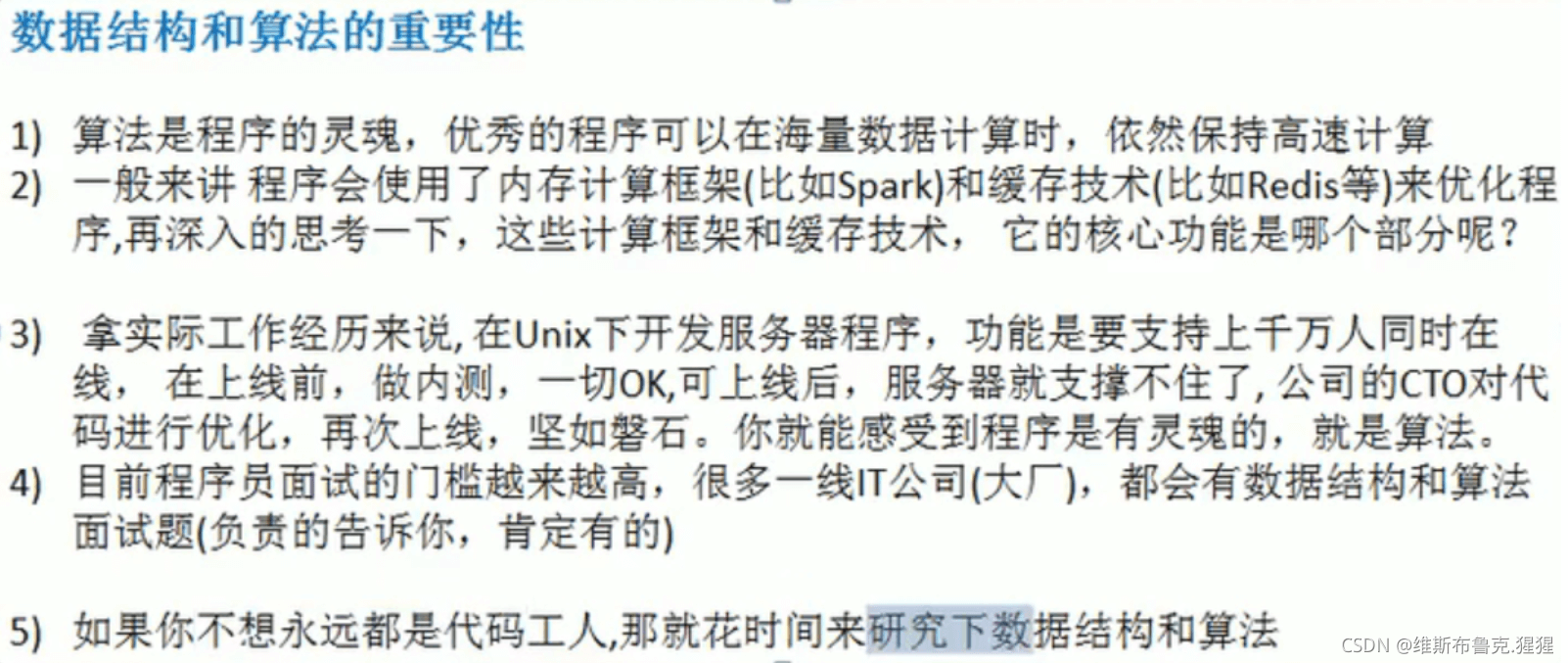


二、稀疏数组
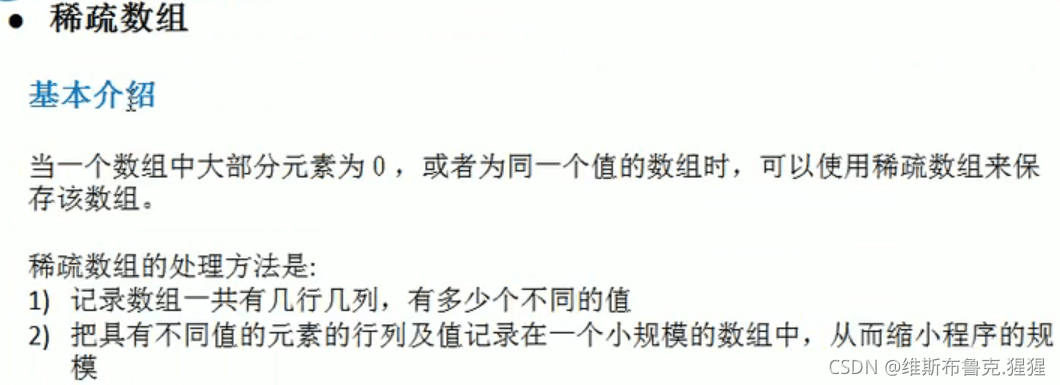
稀疏数组的应用实例
1) 稀疏数组,来保留类似前面的二维数组(棋盘、地图等等)
2) 把稀疏数组存盘,并且可以从新恢复原来的二维数组数据
二维数组与稀疏数组的转换
 二
二
二维数组 转 稀疏数组的思路
1.遍历原始的二维数组,得到有效数据的个数 sum
2.根据sum就可以创建稀疏数组 sparseArr int[sum + 1][3]
3.将二维数组的有效数据存入到稀疏数组
稀疏数组 转 原始的二维数组的思路
1.先读取稀疏数组的第一行,根据第一行的数据,创建原始的二维数组,比如上面的 chessArr2 = int[11][11]
2.在读取稀疏数组后几行的数据,并赋给原始的二维数组即可。
public class SparseArray {
public static void main(String[] args) {
// 创建一个原始的二维数组11 * 11
// 0:表示没有棋子,1表示黑子 2表示蓝子
int chessArr1[][] = new int[11][11];
chessArr1[1][2] = 1;
chessArr1[2][3] = 2;
// 新加的棋子;只需在这加就可以
chessArr1[4][5] = 6;
// 输出原始的二维数组
System.out.println("原始的二维数组~~");
for (int[] row : chessArr1) {
for (int data : row) {
System.out.printf("%d\t", data);
}
System.out.println();
}
// 将二维数组 转 稀疏数组的思路
// 1.先遍历二维数组 得到非0数据的个数
int sum = 0;
for (int i = 0; i < 11; i++) {
for (int j = 0; j < 11; j++) {
if (chessArr1[i][j] != 0) {
sum++;
}
}
}
// 2.创建对应的稀疏数组
int sparseArr[][] = new int[sum + 1][3];
// 给稀疏数组赋值
sparseArr[0][0] = 11;
sparseArr[0][1] = 11;
sparseArr[0][2] = sum;
// 遍历二维数组,将非0的值存放到sparseArr中
int count = 0;// count 用于记录是第几个非0数据
for (int i = 0; i < 11; i++) {
for (int j = 0; j < 11; j++) {
if (chessArr1[i][j] != 0) {
count++;
sparseArr[count][0] = i;
sparseArr[count][1] = j;
sparseArr[count][2] = chessArr1[i][j];
}
}
}
// 输出稀疏数组的形式
System.out.println();
System.out.println("得到稀疏数组为~~~~");
for (int i = 0; i < sparseArr.length; i++) {
System.out.printf("%d\t%d\t%d\t\n", sparseArr[i][0], sparseArr[i][1], sparseArr[i][2]);
}
// 将稀疏数组-->>恢复成原始的二维数组
// 1.先读取稀疏数组的第一行,根据第一行的数据,创建原始的二维数组
int chessArr2[][] = new int[sparseArr[0][0]][sparseArr[0][1]];
// 2.在读取稀疏数组后几行的数据(从第二行开始),并赋给原始的二维数组即可
for (int i = 1; i < sparseArr.length; i++) {
chessArr2[sparseArr[i][0]][sparseArr[i][1]] = sparseArr[i][2];
}
// 输出恢复后的二维数组
System.out.println();
System.out.println("恢复后的二维数组");
for (int[] row : chessArr2) {
for (int data : row) {
System.out.printf("%d\t", data);
}
System.out.println();
}
}
}
三、队列
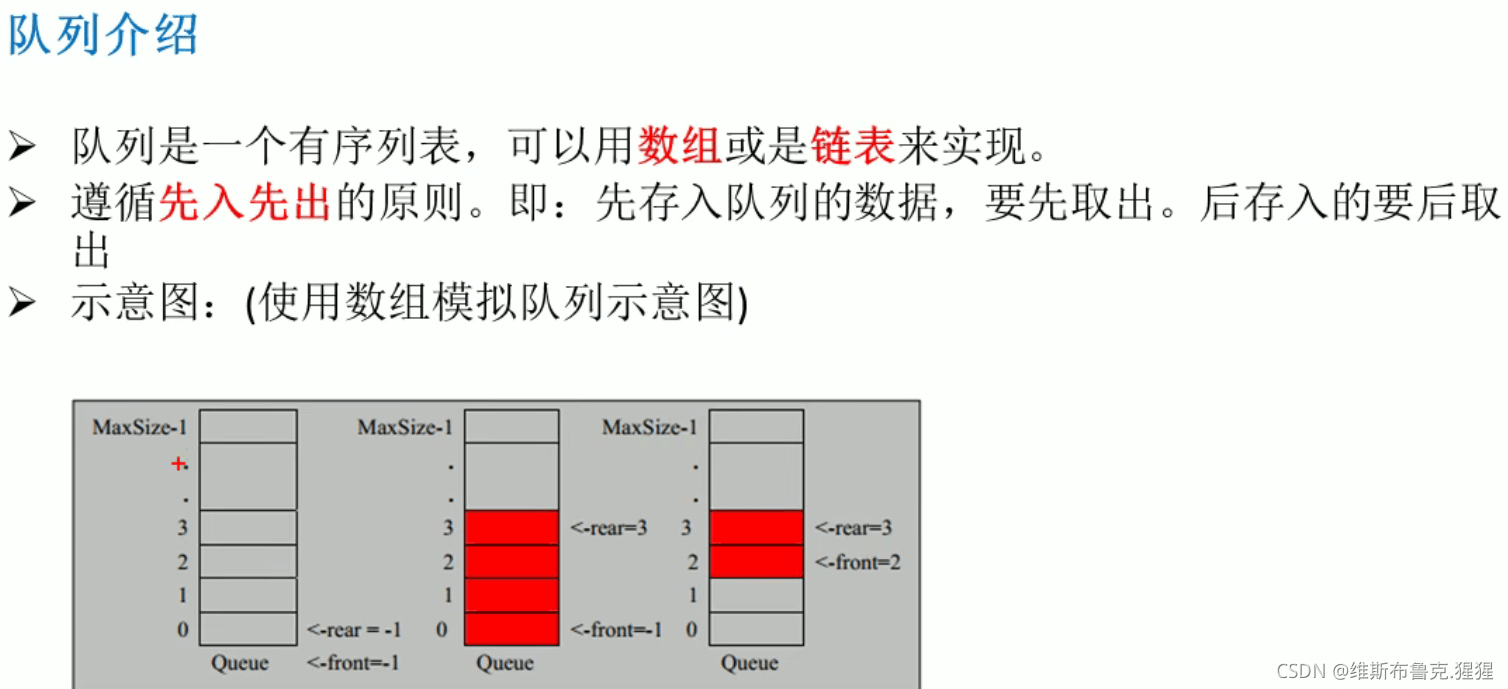
数组模拟队列
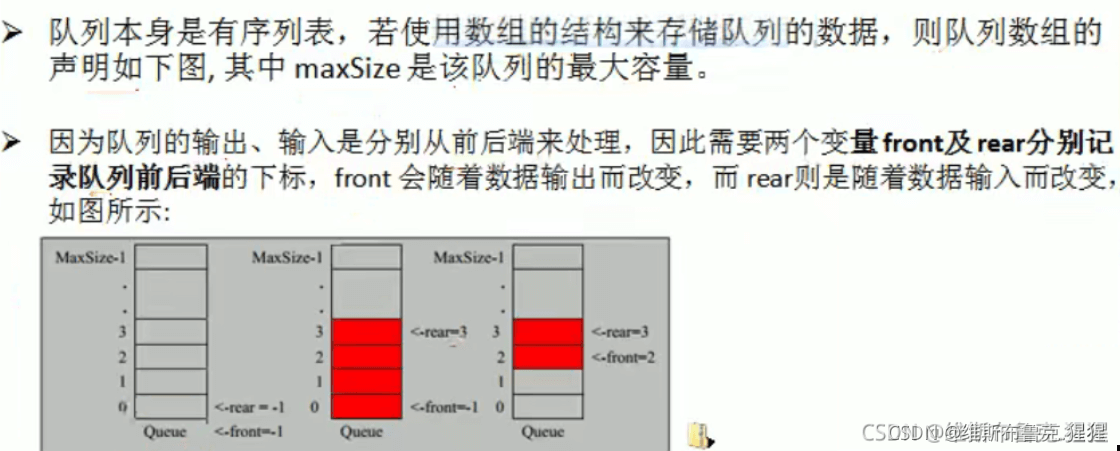
public class ArrayQueueDemo {
public static void main(String[] args) {
//测试一把
//创建一个队列
ArrayQueue queue = new ArrayQueue(3);
char key = ' ';//接收用户输入
Scanner scanner = new Scanner(System.in);
boolean loop = true;
//输出一个菜单
while(loop) {
System.out.println("s(show): 显示队列");
System.out.println("e(exit): 退出程序");
System.out.println("a(add): 添加数据到队列");
System.out.println("g(get): 从队列取出数据");
System.out.println("h(head): 查看队列头的数据");
key = scanner.next().charAt(0);//接收一个字符
switch(key) {
case 's':
queue.showQueue();
break;
case 'a':
System.out.println("输出一个数");
int value = scanner.nextInt();
queue.addQueue(value);
break;
case 'g'://取出数据
try {
int res = queue.getQueue();
System.out.printf("去除的数据是%d\n",res);
} catch (Exception e) {
System.out.println(e.getMessage());
}
break;
case 'h'://查看队列头的数据
try {
int res = queue.headQueue();
System.out.printf("队列头的数据是%d\n",res);
} catch (Exception e) {
System.out.println(e.getMessage());
}
break;
case 'e'://退出
scanner.close();
loop = false;
default:
break;
}
}
System.out.println("程序退出~~");
}
}
//使用数组模拟队列-编写一个ArrayQueue类
class ArrayQueue {
private int maxSize;// 表示数组的最大容量
private int front;// 队列头
private int rear;// 队列尾
private int[] arr;// 该数据用于存放数据,模拟队列
// 创建队列的构造器
public ArrayQueue(int arrMaxSize) {
maxSize = arrMaxSize;
arr = new int[maxSize];
front = -1;// 指向队列头部,分析出front是指向队列头的前一个位置。
rear = -1;// 指向队列尾,指向队列尾的数据(即就是队列的最后一个数据)
}
// 判断队列是否满
public boolean isFull() {
return rear == maxSize - 1;
}
// 判断队列是否为空
public boolean isEmpty() {
return rear == front;
}
// 添加数据到队列
public void addQueue(int n) {
// 判断队列是否满
if (isFull()) {
System.out.println("队列满,不能加入数据~~");
return;
}
rear++;// 让rear 后移
arr[rear] = n;
}
// 获取队列的数据,出队列
public int getQueue() {
// 判断队列是否空
if (isEmpty()) {
// 通过抛出异常
throw new RuntimeException("队列空,不能取数据");
}
front++;// front后移
return arr[front];
}
// 显示队列的所有数据
public void showQueue() {
// 遍历
if (isEmpty()) {
System.out.println("队列空的,没有数据~~");
return;
}
for (int i = 0; i < arr.length; i++) {
System.out.printf("arr[%d]=%d\n", i, arr[i]);
}
}
//显示队列的头数据,注意不是取出数据
public int headQueue() {
//判断
if(isEmpty()) {
throw new RuntimeException("队列空的,没有数据~~");
}
return arr[front + 1];
}
}
上述代码问题分析:
1)目前数组使用一次就不能用,没有达到复用的效果
2)将这个数组使用算法,改进成一个环形的队列(使用到了取模:%相关的算法)
代码优化:数组模拟环形队列

思路如下:
1.front变量的含义做一个调整:front就指向队列的第一个元素,也就是说arr[front]就是队列的第一个元素front的初始值 = 0
2.rear变量的含义做一个调整:rear指向队列的最后一个元素的后一个位置。因为希望空出一个空间做为约定。rear的初始值 = 0
3.当队列满时,条件是[rear + 1] % maxSize == front【满】
4.对队列为空的条件,rear == front空
5.当我们这样分析,队列中有效的数据的个数:(rear + maxSize - front) % maxSize
6.我们就可以在原来的队列上修改得到,一个环形队列
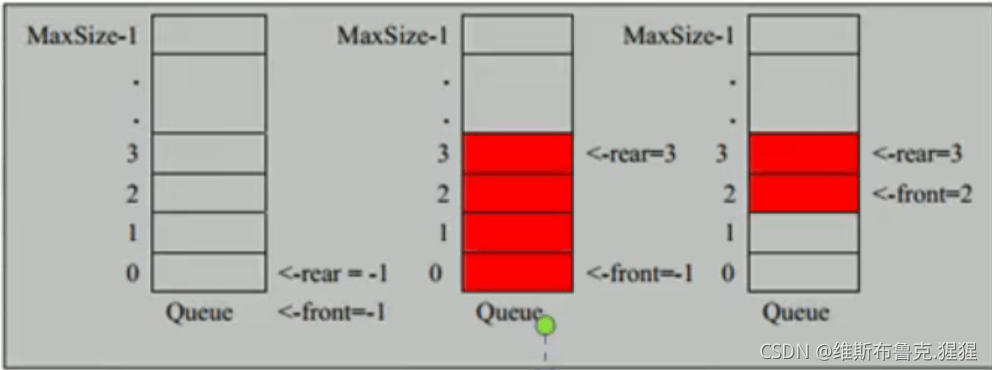
public class CircleArrayQueueDemo {
public static void main(String[] args) {
// 测试
System.out.println("测试数组模拟环形队列的案例~~");
// 创建一个环形队列
CircleArray queue = new CircleArray(4);// 说明设置4,其队列的有效数据最大是3
char key = ' ';// 接收用户输入
Scanner scanner = new Scanner(System.in);
boolean loop = true;
// 输出一个菜单
while (loop) {
System.out.println("s(show): 显示队列");
System.out.println("e(exit): 退出程序");
System.out.println("a(add): 添加数据到队列");
System.out.println("g(get): 从队列取出数据");
System.out.println("h(head): 查看队列头的数据");
key = scanner.next().charAt(0);// 接收一个字符
switch (key) {
case 's':
queue.showQueue();
break;
case 'a':
System.out.println("输出一个数");
int value = scanner.nextInt();
queue.addQueue(value);
break;
case 'g':// 取出数据
try {
int res = queue.getQueue();
System.out.printf("去除的数据是%d\n", res);
} catch (Exception e) {
System.out.println(e.getMessage());
}
break;
case 'h':// 查看队列头的数据
try {
int res = queue.headQueue();
System.out.printf("队列头的数据是%d\n", res);
} catch (Exception e) {
System.out.println(e.getMessage());
}
break;
case 'e':// 退出
scanner.close();
loop = false;
default:
break;
}
}
System.out.println("程序退出~~");
}
}
class CircleArray {
private int maxSize;// 表示数组的最大容量
// front的变量的含义做一个调整:front就指向队列的第一个元素,也就是说arr[front]就是队列的第一个元素
// front的初始值=0
private int front;
// rear变量的含义做一个调整:rear指向队列的最后一个元素的后一个位置.因为希望空出一个空间作为约定。
// rear的初始值=0
private int rear;
private int[] arr;// 该数据用于存放数据,模拟队列
public CircleArray(int arrMaxSize) {
maxSize = arrMaxSize;
arr = new int[maxSize];
}
// 判断队列是否满
public boolean isFull() {
return (rear + 1) % maxSize == front;
}
// 判断队列是否为空
public boolean isEmpty() {
return rear == front;
}
// 添加数据到队列
public void addQueue(int n) {
// 判断队列是否满
if (isFull()) {
System.out.println("队列满,不能加入数据~~");
return;
}
// 直接将数据加入
arr[rear] = n;
// 将rear后移,这里必须考虑取模
rear = (rear + 1) % maxSize;// 这里还有点没理解
}
// 获取队列的数据,出队列
public int getQueue() {// 这里也没理解明白
// 判断队列是否空
if (isEmpty()) {
// 通过异常抛出
throw new RuntimeException("队列空,不能取数据");
}
// 这里需要分析出front时指向队列的第一个元素
// 1.先把front对应的只保留到一个临时变量
// 2.将front后移,考虑取模
// 3.将临时保存的变量返回
int value = arr[front];
front = (front + 1) % maxSize;
return value;
}
// 显示队列的所有数据
public void showQueue() {
// 遍历
if (isEmpty()) {
System.out.println("队列空的,没有数据~~");
return;
}
// 思路:从front开始遍历,遍历多少个元素
// 动脑筋
for (int i = front; i < front + size(); i++) {
System.out.printf("arr[%d]=%d\n", i % maxSize, arr[i % maxSize]);
}
}
// 求出当前队列有效数据的个数
public int size() {
return (rear + maxSize - front) % maxSize;
}
// 显示队列的头数据,注意不是取出数据
public int headQueue() {
// 判断
if (isEmpty()) {
throw new RuntimeException("队列空的,没有数据~~");
}
return arr[front];
}
}
加载全部内容